antarctica
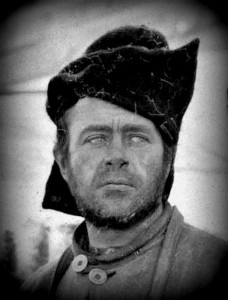
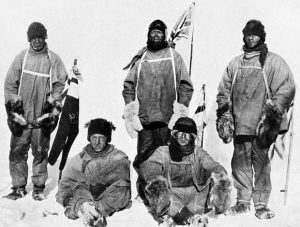 Competition is the driving force behind so many accomplishments, especially world records. On January 18, 1912, after a two-month ordeal, the expedition of British explorer Robert Falcon Scott arrived at the South Pole. Scott was a British naval officer, who began his first Antarctic expedition in 1901 aboard the Discovery. Scott spent three years exploring the area and discovered the Edward VII Peninsula, surveyed the coast of Victoria Land…which were both areas of Antarctica on the Ross Sea, and led limited expeditions into the continent itself.
Competition is the driving force behind so many accomplishments, especially world records. On January 18, 1912, after a two-month ordeal, the expedition of British explorer Robert Falcon Scott arrived at the South Pole. Scott was a British naval officer, who began his first Antarctic expedition in 1901 aboard the Discovery. Scott spent three years exploring the area and discovered the Edward VII Peninsula, surveyed the coast of Victoria Land…which were both areas of Antarctica on the Ross Sea, and led limited expeditions into the continent itself.
Soon, skirting the fringes of Antarctica was not enough, and others had taken an interest in the area too. So, in 1911, Scott and Norwegian explorer, Roald Amundsen began an “undeclared” race to the South Pole. While it was “undeclared,” it was no less a competition, and both men knew it. Sailing his ship into Antarctica’s Bay of Whales, Amundsen set up base camp 60 miles closer to the pole than Scott. In October, both explorers set off. Amundsen was using sleigh dogs and Scott used Siberian motor sledges, Siberian ponies, and dogs. Scott’s journey was fraught with mishaps. The motor sleds broke down, the ponies had to be shot, and the dog teams were sent back as Scott and four companions continued on foot. Nothing was going according to plan.
Nevertheless, on January 18, 1912, Scott’s group finally reached the pole…only to find that Amundsen had preceded them by over a month. Amundsen’s expedition won the race to the pole on December 14, 1911. Encountering good weather on their return trip, they safely reached their base camp in late January. For Scott, 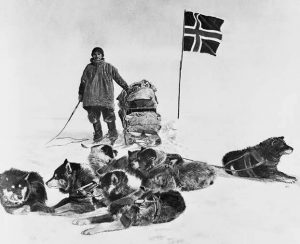
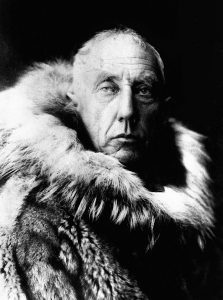 it was a day of mixed feelings, I’m sure. They made it to the pole, but they came in second. The return trip was not going to be much better, but it had to be made. The weather was exceptionally bad, and two members of the team died on the journey back to their base camp. Scott and the other two survivors were trapped in their tent by a storm, when they were just 11 miles from their base camp. Scott, who kept a journal of the trip, like most explorers did, wrote a final entry in his diary in late March. The frozen bodies of he and his two compatriots were recovered eight months later. It was a sad ending to their horrific trip.
it was a day of mixed feelings, I’m sure. They made it to the pole, but they came in second. The return trip was not going to be much better, but it had to be made. The weather was exceptionally bad, and two members of the team died on the journey back to their base camp. Scott and the other two survivors were trapped in their tent by a storm, when they were just 11 miles from their base camp. Scott, who kept a journal of the trip, like most explorers did, wrote a final entry in his diary in late March. The frozen bodies of he and his two compatriots were recovered eight months later. It was a sad ending to their horrific trip.
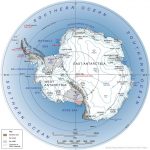
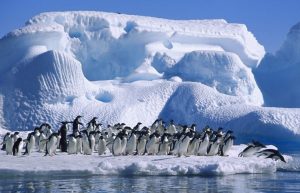 A military-free zone…is there such a place? Most of us don’t think so, but there is, actually. In reality, I can’t imagine fighting a war in Antarctica, but the area has actually been involved in a few disputes. Since the 1800s a number of nations, including Great Britain, Australia, Chile and Norway, have laid claim to parts of Antarctica. I think mostly the purpose for most nations is scientific research, but people have also taken trips across the frozen landscape as a way to challenge themselves. Of course, they didn’t do that in the 1800s.
A military-free zone…is there such a place? Most of us don’t think so, but there is, actually. In reality, I can’t imagine fighting a war in Antarctica, but the area has actually been involved in a few disputes. Since the 1800s a number of nations, including Great Britain, Australia, Chile and Norway, have laid claim to parts of Antarctica. I think mostly the purpose for most nations is scientific research, but people have also taken trips across the frozen landscape as a way to challenge themselves. Of course, they didn’t do that in the 1800s.
Over the years, the competing claims led to diplomatic disputes and even armed clashes. In 1948, Argentine military forces fired on British troops in an area claimed by both nations. Different nations, over the years have disputed lands and fought wars over ownership, and I guess that Antarctica was no different…even if I can’t imagine fighting over a frozen piece of land that, while it is 5,400,000 square miles of land, it is largely covered with ice and snow year round. Still, it seems to me that a continent that is that big would have plenty of room for everyone, but that did not settle the disputes.
Due to the increased number and type of incidents, together with evidence that the Soviet Union was becoming more interested in Antarctica, the United States decided to propose that the continent be made a trustee of the United Nations. This idea was rejected when none of the other nations with interests on the continent would agree to cede their claims of sovereignty to an international organization. That idea didn’t really go over too well either. By the 1950s, some officials in the United States began to press for a more active United States role in Antarctica, believing that the continent might have military potential as an area for nuclear tests. It looked like something was going to have to be done. President Dwight D Eisenhower took a different approach. US diplomats, working with their Soviet counterparts, worked out a treaty that set aside Antarctica as a military-free zone and postponed settling territorial claims for future debate. There could be “no military presence on the continent, and no testing of weapons of any sort, including nuclear weapons. Scientific ventures were allowed, and scientists would not be prohibited from traveling through any of the areas claimed by various nations.” Since the treaty did not directly tamper with issues of territorial sovereignty in Antarctica, the involved 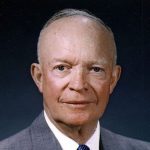
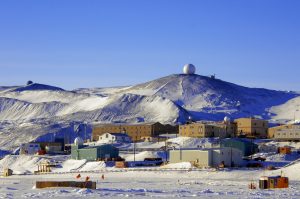 parties included all nations with territorial claims on the continent. As such, the treaty marked a small but significant first step toward US-Soviet arms control and political cooperation. On December 1, 1959, twelve nations, including the United States and the Soviet Union, sign the Antarctica Treaty, which bans military activity and weapons testing on that continent. It was the first arms control agreement signed in the Cold War period. The treaty went into effect in June 1961, and its policies continue to govern Antarctica to this day.
parties included all nations with territorial claims on the continent. As such, the treaty marked a small but significant first step toward US-Soviet arms control and political cooperation. On December 1, 1959, twelve nations, including the United States and the Soviet Union, sign the Antarctica Treaty, which bans military activity and weapons testing on that continent. It was the first arms control agreement signed in the Cold War period. The treaty went into effect in June 1961, and its policies continue to govern Antarctica to this day.

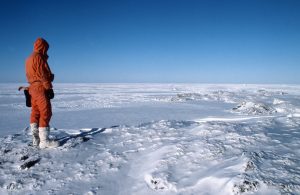 Captain Charles Wilkes was an American naval officer, ship’s captain, and explorer. During an exploring expedition, authorized by the May 18, 1836 act of the Congress, Wilkes set out to explore the southern oceans. Congress didn’t expect his expedition to find anything amazing, but that is where they were wrong. His group set out in 1838, and it was during this expedition that Wilkes spotted the coast of Antarctica. The group had sailed around South America to the South Pacific, and after spotting Antarctica, decided to explore a 1,500 mile stretch of it’s eastern coast. The area later became known a Wilkes Land. In 1842, the expedition returned to New York, after having circumnavigated the globe. Wilkes wasn’t the first explorer to look at Antarctica, however. It was discovered by European and American explorers, and in the February 1821, American John Davis became the first person to land on the continent, coming in at Hughes Bay on the Antarctic Peninsula.
Captain Charles Wilkes was an American naval officer, ship’s captain, and explorer. During an exploring expedition, authorized by the May 18, 1836 act of the Congress, Wilkes set out to explore the southern oceans. Congress didn’t expect his expedition to find anything amazing, but that is where they were wrong. His group set out in 1838, and it was during this expedition that Wilkes spotted the coast of Antarctica. The group had sailed around South America to the South Pacific, and after spotting Antarctica, decided to explore a 1,500 mile stretch of it’s eastern coast. The area later became known a Wilkes Land. In 1842, the expedition returned to New York, after having circumnavigated the globe. Wilkes wasn’t the first explorer to look at Antarctica, however. It was discovered by European and American explorers, and in the February 1821, American John Davis became the first person to land on the continent, coming in at Hughes Bay on the Antarctic Peninsula.
Over the next century, many nations, including the United States, wanted to stake their territorial claims to portions of the frigid continent. I’m sure they all had the same idea for its use. Obviously, it was not going to be a place where people were going to live for any length of time…at least not at first. Scientists do spend quite a bit of time there now, but back then, the necessary facilities and equipment were not available.
Finally, in the 1930s, conflicting claims finally led to international rivalry, and the United States, which led the world in the establishment of scientific bases, enacted an official policy of making no territorial claims while recognizing no other nation’s claims. While it didn’t immediately solve the conflict then, it probably set in 
 motion, the 1959 Antarctic Treaty that made Antarctica an international zone, set guidelines for scientific cooperation, and prohibited military operations, nuclear explosions, and the disposal of radioactive waste on the continent. It’s sometimes strange to think about a continent that has really no owner, or rather is owned by the world, and yet even in modern times we have another such place…the International Soace Station. It’s nice to know that there are some things that we can share globally and actually get along.
motion, the 1959 Antarctic Treaty that made Antarctica an international zone, set guidelines for scientific cooperation, and prohibited military operations, nuclear explosions, and the disposal of radioactive waste on the continent. It’s sometimes strange to think about a continent that has really no owner, or rather is owned by the world, and yet even in modern times we have another such place…the International Soace Station. It’s nice to know that there are some things that we can share globally and actually get along.

